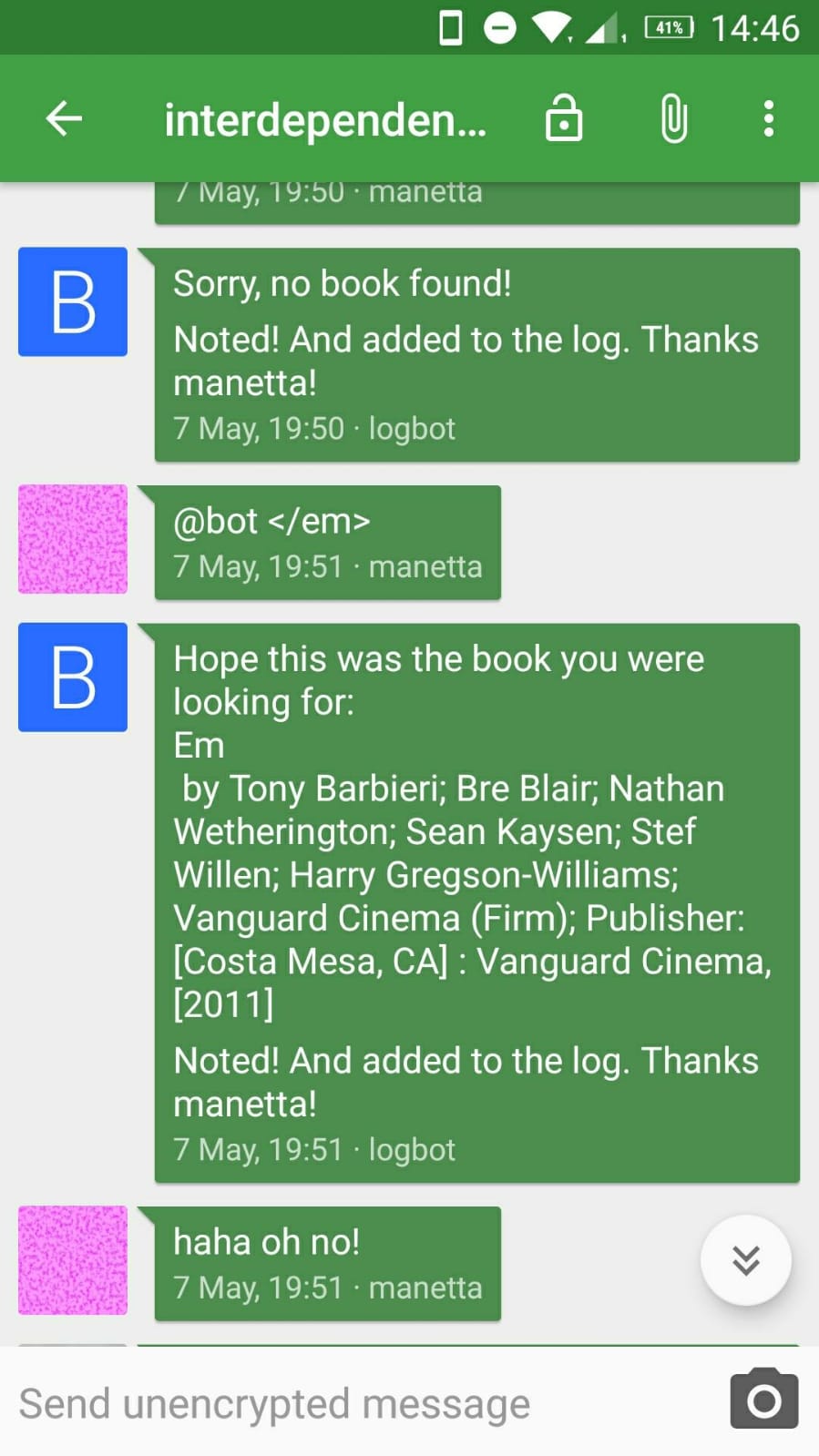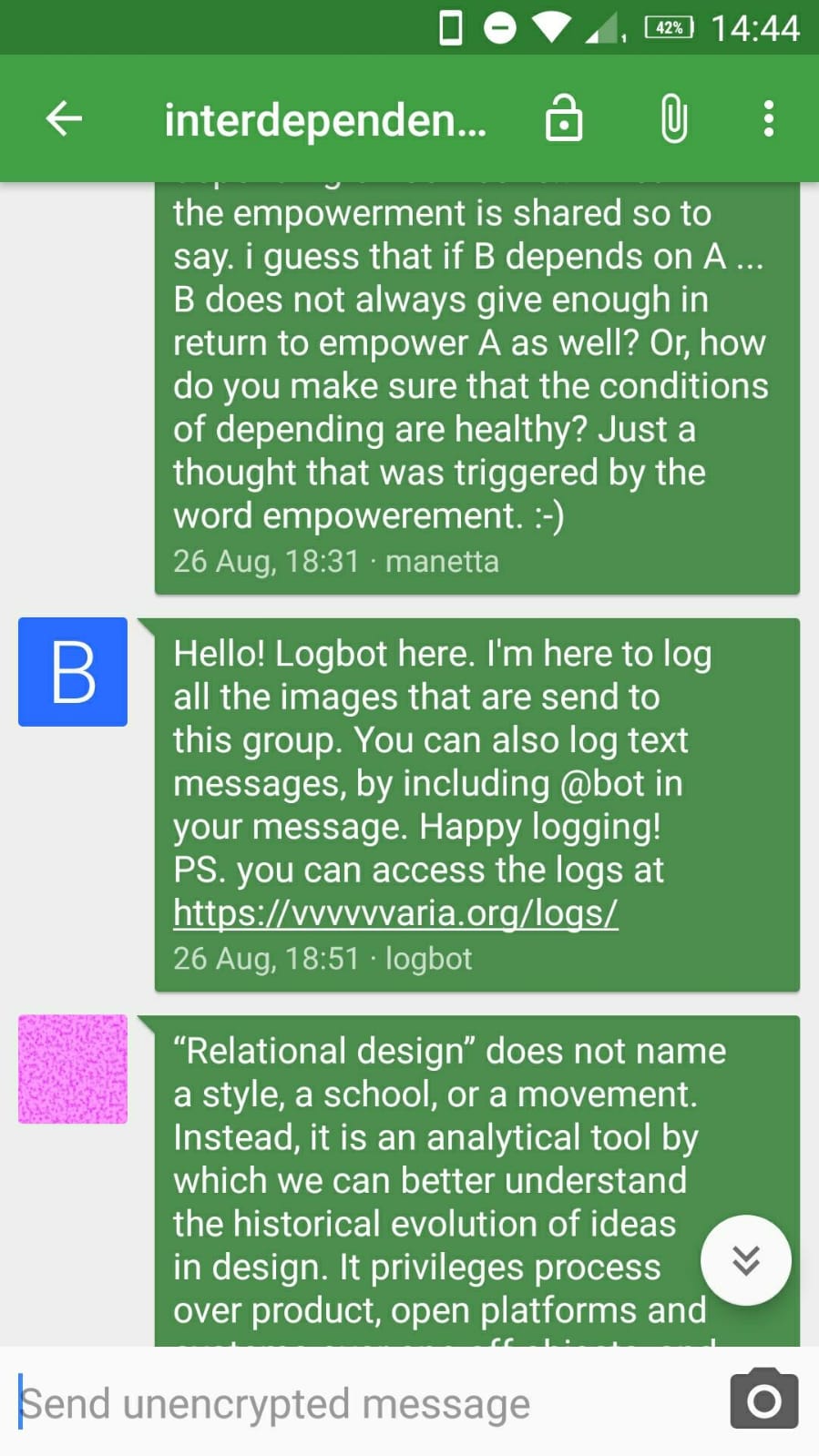| Bots | ||
| Previous iterations | ||
| readings | ||
| log_bot_01.jpg | ||
| log_bot_02.jpg | ||
| README.md | ||
Bots of Conduct
A workshop by Cristina Cochior and Manetta Berends for the department of Communication Design/Information Design at the University of Arts and Design, Halle (Germany) 2020.
Based on a workshop Cristina Cochior and Joana Chicau did for Constant's work session Collective Conditions, Brussels 2019.
Bots as Conversational Tools
Infrapunctural Bots for Stress Relief
Inspired by the potential of digital infrapunctures by Deb Verhoeven, we would like to propose considering what a bot logic might look like:
- where platform logic accumulates, bot logic disperses
- where platform logic centralises, bot logic fragments
- where platform logic creates distance between user and infrastructure, bot logic develops an intimate knowledge of the platform
- where platform logic reinforces habitual behaviour, bot logic encourages new habit formation
A few examples:
Bots as Tools to Intervene in Conversations
What would it mean to become more entangled with bots, redistribute the labour of making and maintaining a collective, but without falling into the metaphorical understanding of bot as a servant?
Varia members use XMPP as a chat protocol because it enables us to self-host our own instance and federate with other chat servers. We use bots both to communicate and to document our exchanges. Our initial idea was to develop new forms of note-taking based on our interaction habits. We share a lot of different types of information in group chats, from news to recommendations of articles to instigations to clean the fridge. Starting from the conversational nature of our exchanges, we are experimenting with two different bot-users in the chat: one that gathers images shared on the main Varia channel and displays them online, and another one, focused specifically on the topic of digital interdependencies, that gathers images, quotes and looks for books' citations.
Working on our own digital infrastructure allows us to adapt the tools to our own needs and behaviours; meaning that these bots make sense to us, but they may not make sense to someone else.


Currently, we use:
- Streambot: a bot that saves the images sent to the main Varia group chat and creates an html page for them.
- Logbot: a bot that logs the quotes that are sent to it.
- You can find a genealogy of the bots around Varia in this footnote1
Let's look into the bots examples:
Transit
name: transit.py
action mode: announces when someone enters or leaves the room
situation: finding non-verbal ways of communicating through presence and absence, making presence felt otherwise
Gather
name: gather.py
action mode: generates a shared language; it creates a collective document
situation: a collective discursive setting that generates its own vocabulary
Greet
name: greet.py
action mode: sends a message when it enters the room
situation: when there is a theme, for example: "send a reference to an existing or imaginary code of conduct, complaint, guideline, bug report, open letter, license or other social-technical protocol and explain why it is of interest to you."; how one wants to be introduced
Spark
name: spark.py
action mode: replies to a specific word; brings alternatives into the situation; tries to create new habits and terminologies
situation: potentially in moments when a situation seems difficult and there is a need for more joyful interactions
Whisper
name: whisper.py
action mode: takes what someone says to it in confidentiality and echoes it to a group chat, thus anonymising it
situation: there are remarks or complaints in the room, but the person does not feel comfortable to bring up the issue themselves
Installing and Running the Bots
During this workshop we will use:
- python3
- pip3
- slixmpp
- a code editor
Some installation guides can be found under the following links.
python3 + pip3:
For computers running Windows OS or Mac OS:
- check what version of Python you have on your computer with
$ python --version - if you have python 2.x, try also the following, to be sure that you don't have python3 already:
$ python3 --version - if this returns a "Could not be found" (or something like that), then proceed to install python3. If it returns a version number, then you have python3 already!
- to install python3, you can download python under the following links and follow the installation instructions:
- https://www.python.org/ftp/python/3.8.3/python-3.8.3-macosx10.9.pkg (Mac OS 10.9 and later)
- https://www.python.org/ftp/python/3.8.3/python-3.8.3-amd64.exe (Windows)
pip3 comes installed with python3.
You can check if it installed correctly by running: $ pip3 --version
For computers running Linux OS:
- open the terminal
- check which version of python you have:
$ python --version
$ python3 --version - if you have a python 2 version, you could install python 3
$ sudo apt install python3
$ sudo apt install python3-pip
slixmpp:
This is the Python library we use to make the bots. You can install it by running: $ pip3 install slixmpp
code editor:
- if you dont have a code editor, we can suggest (among others) Sublime Text or Atom
Run the bots!
First download the bots from this page.
- go to the folder where you have downloaded them
- run the following commands in the terminal:
$ pip3 install slixmpp requests - to run a bot, you can copy paste the commands which are already mentioned in the bot file, but a general command looks like this:
$ python3 bot.py -d -j administratorbot@conversejs.org -r botsofconduct@muc.vvvvvvaria.org -n bot -p testing - where:
-jstands for JID (jabber id)
-rmeans room
-nstands for bot nickname
-ostands for for output
.means here
Join the chatroom!
To join the chatroom, you need to use a XMPP client and an account.
- Start by making a XMPP account.
- We recommend to register one on this server for the workshop: https://blabber.im/anmelden/
- But a longer list of servers can be found here: https://list.jabber.at/
- Use a XMPP client.
- We recommend using Converse.js (a web-client) for this workshop: https://conversejs.org/fullscreen.html
- But if you're curious, you can also install a desktop or mobile client. Some recommendations:
- Conversations (Android): https://conversations.im/
- Chatsecure (iOS): https://chatsecure.org/
- Gajim (Windows, Mac OS, Linux): https://gajim.org/
- Dino (Linux): https://dino.im/
- Join the following room:
botsofconduct@muc.vvvvvvaria.org
Footnotes
Link to references pad — further references and materials assembled by Joana and Cristina - feel free to add your own!
- https://gitlab.com/relearn/relearn2017/blob/master/xmpp-bots/timekeeper-bot/timekeeper.py (Relearn 2017)
- https://gitlab.com/relearn/relearn2017/blob/master/xmpp-bots/collection-bot/collection-bot.py (Relearn 2017)
- https://gitlab.com/relearn/relearn2017/tree/master/xmpp-bots/archive-bot (Relearn 2017)
- https://gitlab.com/relearn/relearn2017/blob/master/xmpp-bots/cake-bot/cake-bot.py (Relearn 2017)
- https://gitlab.com/lidia_p/author-is-not-present/ (Bots by Lidia and Cristina, 2019)
-
genealogy of bots ↩︎
